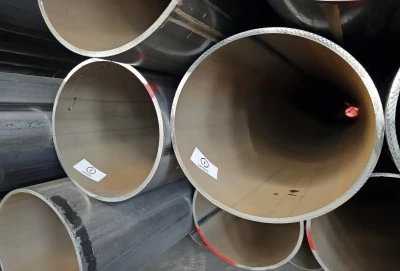When it comes to selecting the right steel pipe for your project, understanding the differences between various grades and specifications is crucial. Two commonly used steel pipe standards are ASTM A500 Grade B and ASTM A53 Grade B. While both are widely used in construction and industrial applications, they have distinct characteristics that make them suitable for different purposes. In this comprehensive guide, we'll explore the key differences between these two steel pipe grades, focusing on their chemical and mechanical properties, manufacturing processes, and ideal applications
|
|
|
Chemical and Mechanical Property Comparisons
ASTM A500 Grade B and ASTM A53 Grade B pipes are both carbon steel products, but they have different chemical compositions and mechanical properties that set them apart. Let's delve into these differences to better understand how they impact the performance and application of each pipe grade.
ASTM A500 Grade B is primarily used for structural applications and is known for its high strength-to-weight ratio. It has a minimum yield strength of 42,000 psi (290 MPa) and a minimum tensile strength of 58,000 psi (400 MPa). The chemical composition of A500 Grade B typically includes:
- Carbon: 0.26% max
- Manganese: 1.20% max
- Phosphorus: 0.035% max
- Sulfur: 0.035% max
On the other hand, ASTM A53 Grade B, commonly referred to as a53 gr.b pipe, is designed for both pressure and general-purpose applications. It has a minimum yield strength of 35,000 psi (240 MPa) and a minimum tensile strength of 60,000 psi (415 MPa). The chemical composition of A53 Grade B typically includes:
- Carbon: 0.30% max
- Manganese: 1.20% max
- Phosphorus: 0.05% max
- Sulfur: 0.045% max
As we can see, A500 Grade B has a higher yield strength but a slightly lower tensile strength compared to A53 Grade B. This makes A500 Grade B more suitable for applications where resistance to deformation under load is crucial. The a53 gr.b pipe, with its higher tensile strength, is better suited for applications that require resistance to ultimate failure.
It's worth noting that while both grades have similar manganese content, A53 Grade B allows for slightly higher carbon, phosphorus, and sulfur content. This difference in chemical composition contributes to the varying mechanical properties and performance characteristics of each grade.
Manufacturing Process Differences between A500 B and A53 B
The manufacturing processes for ASTM A500 Grade B and ASTM A53 Grade B pipes differ significantly, which contributes to their unique properties and applications. Understanding these processes can help in selecting the right pipe for specific projects.
ASTM A500 Grade B pipes are typically manufactured using the cold-forming process. This method involves shaping the steel at room temperature, which results in work hardening of the material. The process begins with hot-rolled steel coils that are uncoiled, leveled, and then formed into a circular, square, or rectangular shape. The edges are then welded together using electric resistance welding (ERW) or induction welding. After welding, the pipe may undergo further cold working to achieve the desired shape and dimensions.
The cold-forming process used for A500 Grade B pipes offers several advantages:
- Improved strength and hardness due to work hardening
- Tighter dimensional tolerances
- Smoother surface finish
- Better consistency in mechanical properties
In contrast, ASTM A53 Grade B pipes, including the a53 gr.b pipe, can be manufactured using several different methods:
- Seamless (SMLS): Produced by hot working steel billets into a tubular shape without welding.
- Electric Resistance Welded (ERW): Similar to A500 Grade B, but typically with less cold working after welding.
- Continuous Welded (CW): An older process where the pipe is formed and welded in a continuous operation from hot-rolled skelp.
The a53 gr.b pipe is most commonly produced using the ERW method, which offers a good balance of cost-effectiveness and quality. The manufacturing process for A53 Grade B pipes typically involves:
- Hot rolling steel into coils
- Uncoiling and edge milling
- Forming into a tubular shape
- Welding the seam using electric resistance welding
- Heat treatment (if required)
- Hydrostatic testing for pressure applications
The various manufacturing methods available for A53 Grade B pipes allow for greater flexibility in production and can be tailored to specific application requirements. For instance, seamless pipes are often preferred for high-pressure applications, while ERW pipes offer a cost-effective solution for general-purpose use.
Structural vs Pressure Applications: Selecting the Right Pipe
When it comes to choosing between ASTM A500 Grade B and ASTM A53 Grade B (a53 gr.b pipe), understanding their ideal applications is crucial. While there is some overlap in their uses, each grade has specific strengths that make it more suitable for certain applications.
ASTM A500 Grade B pipes are primarily designed for structural applications. Their high yield strength and excellent strength-to-weight ratio make them ideal for:
- Building frameworks and support structures
- Bridges and other infrastructure projects
- Agricultural equipment
- Roll-over protection structures (ROPS) for vehicles
- Scaffolding and temporary structures
The superior yield strength of A500 Grade B pipes allows for thinner wall thicknesses in many structural applications, potentially reducing overall weight and material costs. Additionally, their tight dimensional tolerances and smooth surface finish make them suitable for applications where appearance is important.
On the other hand, ASTM A53 Grade B pipes, including the a53 gr.b pipe, are more versatile and can be used in both structural and pressure applications. Their key applications include:
- Low and medium-pressure piping systems
- Fire sprinkler systems
- Steam, water, and gas transmission
- Oil and petrochemical industry piping
- General-purpose structural applications
The a53 gr.b pipe is particularly popular in the construction industry for its balance of strength, weldability, and cost-effectiveness. Its ability to withstand internal pressure makes it suitable for a wide range of fluid and gas transmission applications, while its mechanical properties also allow for use in less demanding structural roles.
When selecting between A500 Grade B and A53 Grade B pipes, consider the following factors:
- Primary application (structural vs. pressure)
- Required strength and load-bearing capacity
- Pressure requirements (if applicable)
- Welding and fabrication needs
- Cost considerations
- Local building codes and industry standards
It's important to note that while A500 Grade B pipes are not typically used for pressure applications, A53 Grade B pipes can often be used as a substitute for A500 Grade B in less demanding structural applications. This versatility is one of the reasons why the a53 gr.b pipe is so widely used across various industries.
Contact Longma
In conclusion, while ASTM A500 Grade B and ASTM A53 Grade B pipes share some similarities, they have distinct characteristics that make them suitable for different applications. A500 Grade B excels in structural applications due to its high yield strength and excellent strength-to-weight ratio, while A53 Grade B, including the versatile a53 gr.b pipe, offers greater flexibility for both structural and pressure applications.
Understanding the chemical compositions, mechanical properties, manufacturing processes, and ideal applications of these pipe grades is essential for making informed decisions in your projects. By carefully considering your specific requirements and consulting with experts, you can ensure that you select the most appropriate pipe grade for your needs, optimizing performance, safety, and cost-effectiveness.
For high-quality steel pipes that meet your project's specific requirements, consider partnering with Longma Group. As one of China's leading ERW/LSAW steel pipe manufacturers since 2003, Longma Group specializes in producing large-diameter, thick-walled, double-sided, sub-arc-seam welding steel pipes, including LSAW (Longitudinal Submerged Arc Welded) and ERW steel pipes. With an annual output exceeding 1,000,000 tons by the end of 2023, Longma Group has the capacity and expertise to meet your steel pipe needs. For more information or to discuss your project requirements, please contact us at info@longma-group.com.














